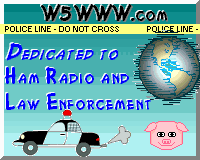The following post is taken from excerpts from a USENET newsgroup post by Jim Miccolis, N2EY to the rec.radio.amateur.moderated newsgroup
The reason I'm posting this is because there is SO MUCH truth in what he says and the correlation between the economic problems of today & the era of The Great Depression.
I've been following the various political debates this election year, and the whole $700 billion bailout mess. How it happened, how to fix it, who is to blame, etc. From all that, it seems to me that we're looking at some pretty lean economic times ahead. But this isn't really a post about politics or economics. It's about their effect on ham radio, specifically, growth in our numbers. Looking back of the history of US ham radio, it seems to me that the worst economic times were the best for US ham radio growth.
Consider that: In the 1920s, the number of licensed US hams grew very slowly, if at all, despite the new technologies of tubes and short waves. By 1929 there were only about 18,000 licensed US amateurs, not much more than in 1920. The Roaring '20s radio boom was in broadcasting, whose development has many parallels to that of the internet in the '90s and '00s. Then in 1929 came two major changes for US hams. First were the "1929 regulations" that greatly narrowed the US ham bands and required much cleaner signals than before.
A lot of existing transmitters had to be extensively modified if not completely rebuilt to meet the new rules, and hams on bands like 40 and 20 were crowded into much less spectrum than before. (In those days the ham bands were far fewer than today, and simply getting a transmitter to work well on one band was a challenge). For example, 40 was reduced in width from 1000 kHz to 300, 20 was reduced from 2000 kHz to 400. Later in 1929 the stock market crashed and the Great Depression began. Hard times lasted all through the 1930s.
There was also the Dust Bowl that displaced large numbers of Americans from their farms. (May we never see such hard times again!) Yet from 1929 to 1937 the number of licensed US hams almost tripled. In percentage terms it was the time of the greatest growth US amateur radio has ever seen. As prosperity began to return in the late 1930s, the growth slowed down. WW2 shut down US amateur radio for the first half of the 1940s.
When the war ended, there was rapid growth despite all the disruption of the war, plus rising prices and shortages in the postwar economy as wage and price controls were removed. Of course a big part of that growth was from people who had put off becoming hams during the war, and later from the restructuring of 1951 that created the Novice license. But in the five years from VJ Day to the beginning of 1951, the number of US hams almost doubled, passing 100,000 in the process.
The 1960s were good economic times, yet through that decade US amateur radio growth was almost nil, similar to the 1920s. The radio boom in the 1960s was in cb, not amateur radio. Then in 1968 the new "incentive licensing" regulations came into effect, and in the 1970s problems of inflation, high interest rates, unemployment, energy crises and lack of economic growth hit the US economy very hard. Just look at gasoline prices - less than a quarter a gallon for cheap gas in 1969, a dollar and a half ten years later. It wasn't until the mid-1980s that things really stabilized. Yet all through the 1970s and into the 1980s the number of US hams grew steadily, from about 270,000 in 1969 to about twice that number in the mid-1980s.
Since the early 1990s until today, we've had (at best) slow growth in the number of US hams, and (at worst) a decline, even though the price of a ham rig in inflation-adjusted dollars has decreased greatly and the licenses are far easier to earn. The boom in these years has been in "wireless" (an old term reused!) rather than amateur radio. The only exception to the pattern of hard times = ham radio growth I can find is the 1950s, which were economic good times (at least the later 1950s). In that decade the growth of the late 1940s continued steadily, so that by the early 1960s there were about 250,000 licensed US hams.
Besides the then-new Novice license, the 1950s were a time when there was lots of WW2 surplus radio gear available at bargain prices. It was also the heyday of inexpensive but decent quality kit rigs from Heath, Johnson, Eico and others. The highest sunspot peak in recorded history happened in 1958, and the Cold War caused a lot of interest in civil defense communications by hams. Perhaps the connection is that, in hard economic times, people's recreation shifts away from going out, traveling, and making big purchases, and changes to things they can do hunkered down at home for a little money and a lot of ingenuity.
Certainly most of the ham stations of the 1930s fit that description. While new ham gear and a big station are expensive, a small homebrew or used-equipment station with a simple antenna can provide very good results if used with skill, patience and there are decent conditions. What do others think? Could we be in for another time of growth for US ham radio? The Dow is down, house prices are down, credit is tight and taxes are just about guaranteed to rise. But sunspots are on the way.... 73 de Jim, N2EY






No comments:
Post a Comment